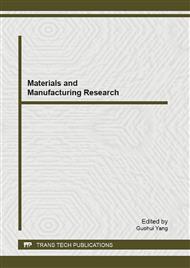p.80
p.85
p.89
p.93
p.97
p.102
p.108
p.112
p.116
Effect of NiO Nanoparticles on Magnetic Polymer Electrolyte for Dye-Sensitized Solar Cells
Abstract:
A magnetic polymer electrolyte using agarose as polymer matrix, NMP as solvent and NiO nanoparticles as modifier was investigated and employed in the dye-sensitized solar cell (DSSC) in this paper. The influence of NiO nanoparticles content on magnetic polymer electrolyte was characterized by SEM and ionic conductivity test. The photovoltaic properties of the corresponding DSSCs were studied by photovoltaic performance tests. The results showed that the surface morphology of the polymer electrolyte with 1.0wt% NiO nanoparticles was smooth and this magnetic polymer electrolyte showed the maximum conductivity (2.43×10-3S•cm-1). The optimal photoelectric efficiency of 1.63% was achieved at the NiO nanoparticles content of 1.0wt%.
Info:
Periodical:
Pages:
97-101
Citation:
Online since:
January 2013
Authors:
Price:
Сopyright:
© 2013 Trans Tech Publications Ltd. All Rights Reserved
Share:
Citation:



